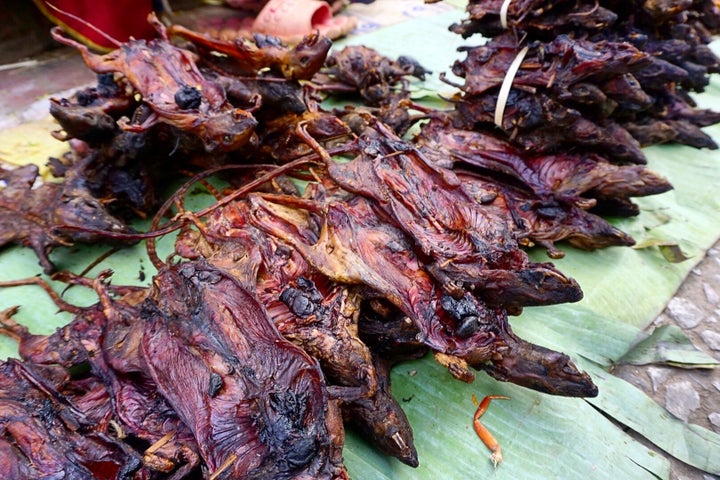
I have always been an adventurous eater. From skewered bull penis in Beijing to beating snake heart in Hanoi to ant larvae tacos in Mexico City, I am a curious omnivore who is willing to try anything once. It took a village in the rural mountains of Laos, however, to truly test my gastronomic fortitude.
During my three weeks traversing the country, street meat stalls became a comforting constant in my ever-changing surroundings. There is no better way to slip into the leisurely Lao pace of life than by noshing on succulent pork ribs, marinated chicken thighs, and unidentifiable meaty bits while crouched on plastic stools with the locals. I felt a sense of camraderie with my neighbors who smiled approvingly when I mopped the juices from around my mouth with sticky rice, before eating it too. In these inclusive roadside eateries, language barriers are trumped by a universal appreciation of grilled meats and no one questions whether it is too early for your first Beerlao of the day. It was here, among the street meaters, where I belonged.
That feeling of solidarity with my tribe was shaken to its core one foggy morning on my routine breakfast pilgrimage to the stalls clustered in Nong Khiaw’s center. Approaching the squatted grill master with a smile, I stopped dead in my tracks. A knotted pink tail was swinging between her legs as she vigorously removed the rat’s coat in swift, deliberate strokes of the blade. Drops of blood pooled at her feet as she expertly sliced up the rodent and tossed it onto the grill alongside the other meats. My stomach lurched and a feeling of acute nausea spread through my entire body as I made the connection between these carriers of disease and my daily dining ritual. My mind reeling, I beelined for the neighboring produce stand and began to chain-eat oranges instead. My unshakeable relationship with street meat had just become complicated.
The near certainty of having unwittingly eaten rat disturbed me deeply; its hidden presence within the humble cuisine I had come to love was an assault on my psyche. Had I found my culinary kryptonite in the filthy dwellers of subway systems and dark alleys the world over?
As I pondered my conundrum, the valuable lessons and genuine relationships formed through my Laotian street encounters came flooding back.
When I first arrived in the unfamiliar southern city of Pakse, weak and disoriented after a nine-turned-fourteen hour bus ride from Bangkok, I found nourishment in streetside lemongrass and ginger-infused pork sausages and a kindred spirit in the amiable local hand-stuffing each one with pride.
During a three-day motorbike trip through the elevated Bolaven Plateau — a region ripe with Arabica coffee, picturesque waterfalls, and streetside grill huts galore — I cured my hunger on the road with crisped pork belly and tender balls of mystery meat. In one smoky den a gracious griller taught me proper sticky rice etiquette by urging me to rip off a hunk of the dense starch from a communal basket and wrap it around my meat before dunking it in a slew of fermented pastes and chili-spiked vinegars. Days later, hovering over a heaping plate of road snacks, I was invited to join a table of students at an underground karaoke club where being publicly serenaded was made tolerable, and then hilarious, by hosts who never let my cup run dry.
As the sun sank lazily behind Nong Khiaw’s dramatic karst cliffs that evening, my initial disgust was replaced with the realization that street meat — rat likely included — had been at the heart of my most meaningful memories in Laos, prompting me to question my bias against the rodent itself.
If I’d been aware of the possibility that its flesh was simmering within my sausages, would I have enjoyed them with such unadulterated joy? Would I have made the same connections with locals who found amusement in my undiscerning enthusiasm to try everything on offer? Perhaps most importantly, could I really fathom giving up street meat in a country where it had become an all-encompassing lifestyle?
The following week, after enjoying the final sunrise of my trip in the former royal capital of Luang Prabang, I strolled through the morning market where ingredients were sold for the day’s cooking. I wandered past stalls of live frogs bound together at the feet, slithering snakes in bowls, and baskets piled high with dried scorpions. It wasn’t long before I spotted the rats. They had been butterflied, leaving their charred innards exposed, and I picked one up to examine the creature that had triggered my internal dilemma. Its tiny bones and sparse pockets of meat did little for my appetite, but it no longer revolted me, either. Strangely enough, I felt a kind of gratitude to the rodents that had taught me that my desire for authentic feasting experiences was far stronger than my fear of vermin.
